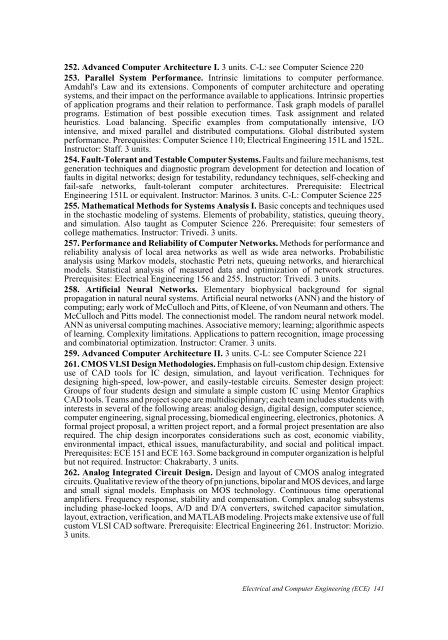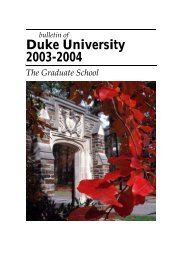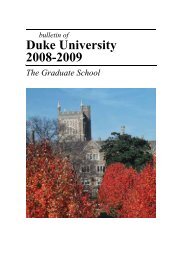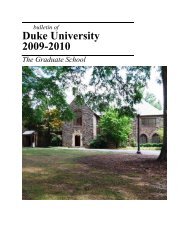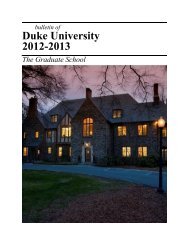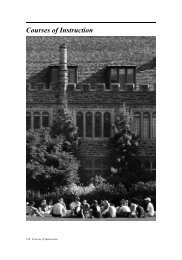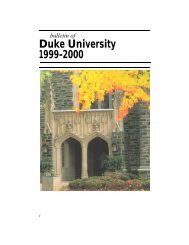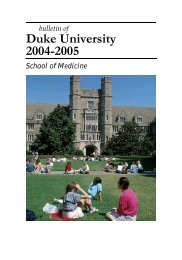2005-06 - Office of the Registrar - Duke University
2005-06 - Office of the Registrar - Duke University
2005-06 - Office of the Registrar - Duke University
You also want an ePaper? Increase the reach of your titles
YUMPU automatically turns print PDFs into web optimized ePapers that Google loves.
252. Advanced Computer Architecture I. 3 units. C-L: see Computer Science 220<br />
253. Parallel System Performance. Intrinsic limitations to computer performance.<br />
Amdahl's Law and its extensions. Components <strong>of</strong> computer architecture and operating<br />
systems, and <strong>the</strong>ir impact on <strong>the</strong> performance available to applications. Intrinsic properties<br />
<strong>of</strong> application programs and <strong>the</strong>ir relation to performance. Task graph models <strong>of</strong> parallel<br />
programs. Estimation <strong>of</strong> best possible execution times. Task assignment and related<br />
heuristics. Load balancing. Specific examples from computationally intensive, I/O<br />
intensive, and mixed parallel and distributed computations. Global distributed system<br />
performance. Prerequisites: Computer Science 110; Electrical Engineering 151L and 152L.<br />
Instructor: Staff. 3 units.<br />
254. Fault-Tolerant and Testable Computer Systems. Faults and failure mechanisms, test<br />
generation techniques and diagnostic program development for detection and location <strong>of</strong><br />
faults in digital networks; design for testability, redundancy techniques, self-checking and<br />
fail-safe networks, fault-tolerant computer architectures. Prerequisite: Electrical<br />
Engineering 151L or equivalent. Instructor: Marinos. 3 units. C-L: Computer Science 225<br />
255. Ma<strong>the</strong>matical Methods for Systems Analysis I. Basic concepts and techniques used<br />
in <strong>the</strong> stochastic modeling <strong>of</strong> systems. Elements <strong>of</strong> probability, statistics, queuing <strong>the</strong>ory,<br />
and simulation. Also taught as Computer Science 226. Prerequisite: four semesters <strong>of</strong><br />
college ma<strong>the</strong>matics. Instructor: Trivedi. 3 units.<br />
257. Performance and Reliability <strong>of</strong> Computer Networks. Methods for performance and<br />
reliability analysis <strong>of</strong> local area networks as well as wide area networks. Probabilistic<br />
analysis using Markov models, stochastic Petri nets, queuing networks, and hierarchical<br />
models. Statistical analysis <strong>of</strong> measured data and optimization <strong>of</strong> network structures.<br />
Prerequisites: Electrical Engineering 156 and 255. Instructor: Trivedi. 3 units.<br />
258. Artificial Neural Networks. Elementary biophysical background for signal<br />
propagation in natural neural systems. Artificial neural networks (ANN) and <strong>the</strong> history <strong>of</strong><br />
computing; early work <strong>of</strong> McCulloch and Pitts, <strong>of</strong> Kleene, <strong>of</strong> von Neumann and o<strong>the</strong>rs. The<br />
McCulloch and Pitts model. The connectionist model. The random neural network model.<br />
ANN as universal computing machines. Associative memory; learning; algorithmic aspects<br />
<strong>of</strong> learning. Complexity limitations. Applications to pattern recognition, image processing<br />
and combinatorial optimization. Instructor: Cramer. 3 units.<br />
259. Advanced Computer Architecture II. 3 units. C-L: see Computer Science 221<br />
261. CMOS VLSI Design Methodologies. Emphasis on full-custom chip design. Extensive<br />
use <strong>of</strong> CAD tools for IC design, simulation, and layout verification. Techniques for<br />
designing high-speed, low-power, and easily-testable circuits. Semester design project:<br />
Groups <strong>of</strong> four students design and simulate a simple custom IC using Mentor Graphics<br />
CAD tools. Teams and project scope are multidisciplinary; each team includes students with<br />
interests in several <strong>of</strong> <strong>the</strong> following areas: analog design, digital design, computer science,<br />
computer engineering, signal processing, biomedical engineering, electronics, photonics. A<br />
formal project proposal, a written project report, and a formal project presentation are also<br />
required. The chip design incorporates considerations such as cost, economic viability,<br />
environmental impact, ethical issues, manufacturability, and social and political impact.<br />
Prerequisites: ECE 151 and ECE 163. Some background in computer organization is helpful<br />
but not required. Instructor: Chakrabarty. 3 units.<br />
262. Analog Integrated Circuit Design. Design and layout <strong>of</strong> CMOS analog integrated<br />
circuits. Qualitative review <strong>of</strong> <strong>the</strong> <strong>the</strong>ory <strong>of</strong> pn junctions, bipolar and MOS devices, and large<br />
and small signal models. Emphasis on MOS technology. Continuous time operational<br />
amplifiers. Frequency response, stability and compensation. Complex analog subsystems<br />
including phase-locked loops, A/D and D/A converters, switched capacitor simulation,<br />
layout, extraction, verification, and MATLAB modeling. Projects make extensive use <strong>of</strong> full<br />
custom VLSI CAD s<strong>of</strong>tware. Prerequisite: Electrical Engineering 261. Instructor: Morizio.<br />
3 units.<br />
Electrical and Computer Engineering (ECE) 141


